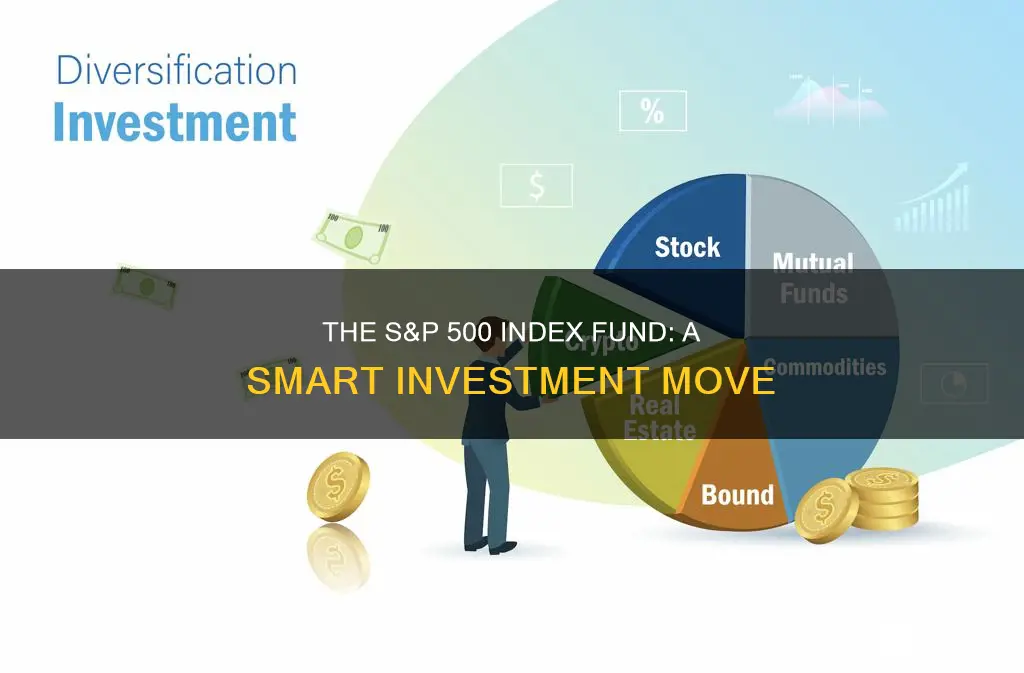
The S&P 500 index fund is a popular investment option, and for good reason. The fund is based on an index of around 500 leading US companies, providing investors with broad exposure to a diverse range of stocks. By investing in an S&P 500 index fund, you can instantly diversify your portfolio, gaining access to hundreds of stocks across various industries and sectors. This diversification helps to lower risk, as poor performance by one company will not significantly impact your overall investment.
The fund also offers solid returns, with an average annual return of about 10% over time. It is a passively managed investment, which means lower fees and more of your money going into the actual investment. The fund is also easy to buy and requires little time or expertise, making it a great option for those new to investing.
Overall, the S&P 500 index fund is a solid choice for investors seeking broad market exposure, diversification, and solid returns.
| Characteristics | Values |
|---|---|
| Annual average return | 10% |
| Number of companies | 500 |
| Investment options | Index funds, ETFs, individual stocks |
| Diversification | High |
| Cost | Low |
| Performance | Solid |
| Ease of purchase | Easy |
| Constituent stocks include | Microsoft, Amazon, Alphabet, Meta, Berkshire Hathaway, Eli Lilly, Broadcom |
| Top sectors | Information Technology, Financials, Healthcare |
| Index funds vs ETFs | ETFs can be traded throughout the day like stocks, index funds can only be bought and sold at the end of the trading day |
What You'll Learn

Instant diversification
The S&P 500 index fund is designed to mirror the performance of the S&P 500 index, which has historically returned about 10% annually on average over the long term. By investing in this index fund, you can expect to achieve similar returns with less volatility compared to investing in individual stocks.
The S&P 500 index fund offers instant diversification by providing access to a wide range of companies in various sectors. As of April 2024, the three sectors with the largest concentration of companies in the S&P 500 were Information Technology (29.2%), Financials (13.1%), and Healthcare (12.3%). This diversification across sectors helps to further reduce risk in your investment portfolio.
The S&P 500 index fund also provides instant diversification in terms of company size. The index includes a mix of large-cap, mid-cap, and small-cap companies, although it is dominated by large-cap companies. The top 10 constituents of the index by weight include well-known companies such as Microsoft, Amazon, Alphabet, and Meta Platforms.
In summary, investing in an S&P 500 index fund offers instant diversification by providing access to a broad range of companies across different sectors and sizes. This diversification helps to reduce investment risk and can lead to more consistent long-term returns.
Investing in NVIDIA: Top Mutual Funds to Consider
You may want to see also

Low cost
S&P 500 index funds are a popular investment choice due to their low cost, or low expense ratios. Index funds are passively managed, meaning they are not trying to beat the market but rather mimic it. As a result, they are less expensive than other types of investing, and more of your money goes into the investment itself rather than being paid out in fund manager fees.
Index funds are also easy to buy, and you can set up your account to buy them automatically. Many S&P 500 index funds charge less than 0.10% annually. To put that into perspective, if the fund charges 0.10%, you will pay $10 annually per $10,000 invested in the fund. Some funds are even less expensive than this, and there are some that are completely free.
When choosing an index fund, you will want to look at the expense ratio and sales load. The expense ratio is the cost charged by the fund manager as a percentage of your investment in the fund. Sales load is a commission charged by the fund manager, and this type of expense should be avoided.
Compared to other types of funds, S&P 500 index funds tend to have slightly higher fees than ETFs because of their higher operating expenses. However, the difference in fees between the two is marginal these days.
Mutual Funds: Where to Invest for Maximum Returns
You may want to see also

Solid performance
The S&P 500 index fund is a good investment option for those seeking solid performance. Over the last century, the S&P 500 has returned about 10% per year on average, making it a reliable choice for investors.
The S&P 500 index fund offers broad exposure to the largest and most dynamic U.S. companies, such as Apple, Amazon, Microsoft, and Johnson & Johnson. By investing in this index fund, individuals can gain access to a diverse range of stocks and benefit from the collective performance of these leading companies.
Additionally, the S&P 500 index fund provides consistent long-term returns. While returns may vary from year to year, the index has consistently performed well over an extended period. This consistency makes it a stable choice for those seeking solid and dependable returns.
Another advantage of the S&P 500 index fund is that it does not require intricate analysis or stock-picking skills. The fund automatically adjusts its holdings based on the underlying index, eliminating the need for investors to actively select stocks. This passive investment strategy makes it easier for individuals to invest without extensive knowledge or time commitment.
The solid performance of the S&P 500 index fund can be attributed to its broad diversification, consistent returns, and ease of investment. It is an attractive option for those seeking a reliable and well-diversified investment with strong historical returns.
Mutual Funds: Investors Seek Diversification and Professional Management
You may want to see also

Easy to buy
S&P 500 index funds are easy to buy. You can set up your account to buy the index fund on autopilot, so you don't have to monitor the account. Here's how to get started:
- Find your S&P 500 index fund: Compare expense ratios and sales loads to determine the cost of the fund. S&P 500 index funds have some of the lowest expense ratios on the market.
- Go to your investing account or open a new one: Access your investing account, such as a 401(k), IRA, or brokerage account. If you don't have an account, you can open one in 15 minutes or less.
- Determine how much you can afford to invest: Figure out how much you can invest regularly and aim to hold it in the account for at least three to five years.
- Buy the index fund: Go to your broker's website and set up the trade, inputting the fund's ticker symbol and the number of shares you'd like to buy. You can also set up an investing schedule to buy the fund on a recurring basis.
S&P 500 index funds are a simple and popular investment choice. They allow you to gain exposure to a diverse range of stocks and companies with minimal effort and expertise. By investing in an S&P 500 index fund, you can instantly diversify your portfolio and benefit from the solid performance of the S&P 500 over time.
RIA Mutual Fund Investment: What's the Catch?
You may want to see also

Exposure to the world's most dynamic companies
The S&P 500 index fund is composed of 500 leading U.S. companies, including some of the world's most dynamic companies such as Apple, Amazon, Microsoft, Walmart, and Johnson & Johnson. These companies represent about 80% of the total U.S. stock market's value.
The S&P 500 index fund provides investors with broad exposure to the constituent stocks in the index. It offers a simple way to invest in the index by replicating the returns of the S&P 500, allowing investors to benefit from the performance of these dynamic companies without the effort of purchasing individual stocks.
By investing in an S&P 500 index fund, individuals gain access to some of the most innovative and influential companies in the world. These companies are known for their strong growth and performance, contributing to the consistent long-term returns of the S&P 500.
The S&P 500 index fund provides an opportunity for investors to diversify their portfolios and gain exposure to a wide range of industries. It is an ideal choice for those seeking a core holding in their investment portfolios due to its liquidity and tight bid-ask spreads.
With its broad reach and access to leading companies, the S&P 500 index fund offers a compelling investment opportunity for those seeking exposure to the world's most dynamic and influential companies.
Mutual Fund Investment: Strategies, Risks, and Rewards
You may want to see also
Frequently asked questions
An S&P 500 index fund is a great way to diversify your portfolio instantly. It allows you to own a stake in hundreds of stocks, even if you own just one share of the index fund. The fund is based on the S&P 500 index, which includes 500 leading U.S. companies, and has returned an average of about 10% annually over time.
The S&P 500 index fund offers broad exposure to some of the world's most dynamic companies, such as Apple, Amazon, Microsoft, and Johnson & Johnson. It has consistently performed well over the long term, and investors do not need to analyze or pick stocks. The fund is also highly liquid and trades with tight bid-ask spreads, making it ideal as a core holding for most investment portfolios.
When choosing an S&P 500 index fund, look for funds with low expense ratios, several years of operation, and a healthy amount of assets under management (AUM). The expense ratio is an annual fee expressed as a percentage of your investment, so a lower ratio is preferable. A longer track record will give you more information about the fund's performance history, and a higher AUM may indicate greater stability in volatile markets.
One drawback of the S&P 500 index fund is that it is dominated by large-cap companies, with limited exposure to small-cap and mid-cap stocks that may have higher growth potential. Additionally, it only includes U.S. companies, and there are inherent risks associated with equity investing, such as volatility and downside risk.







